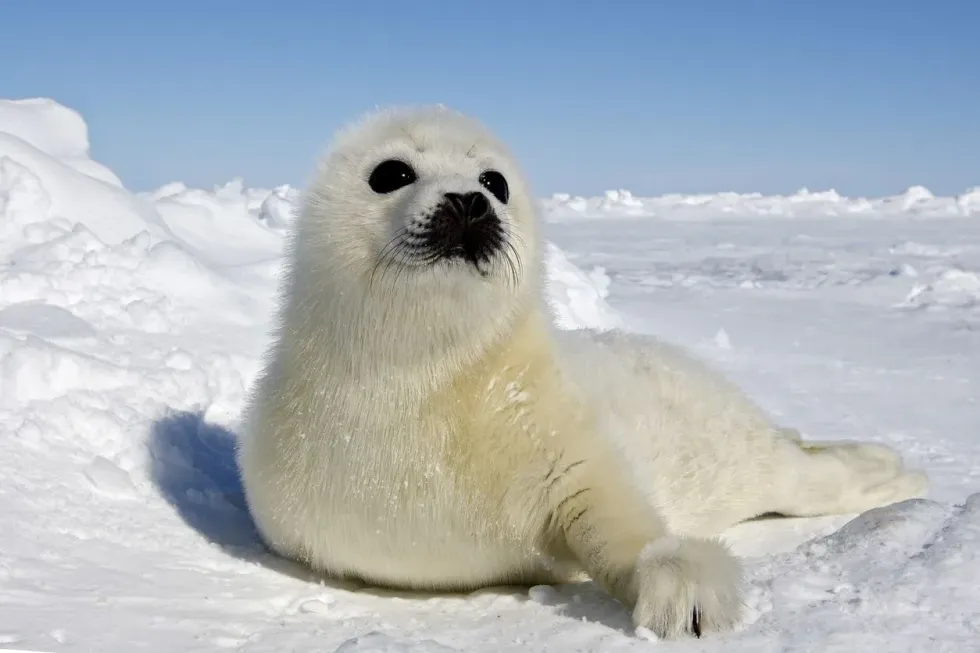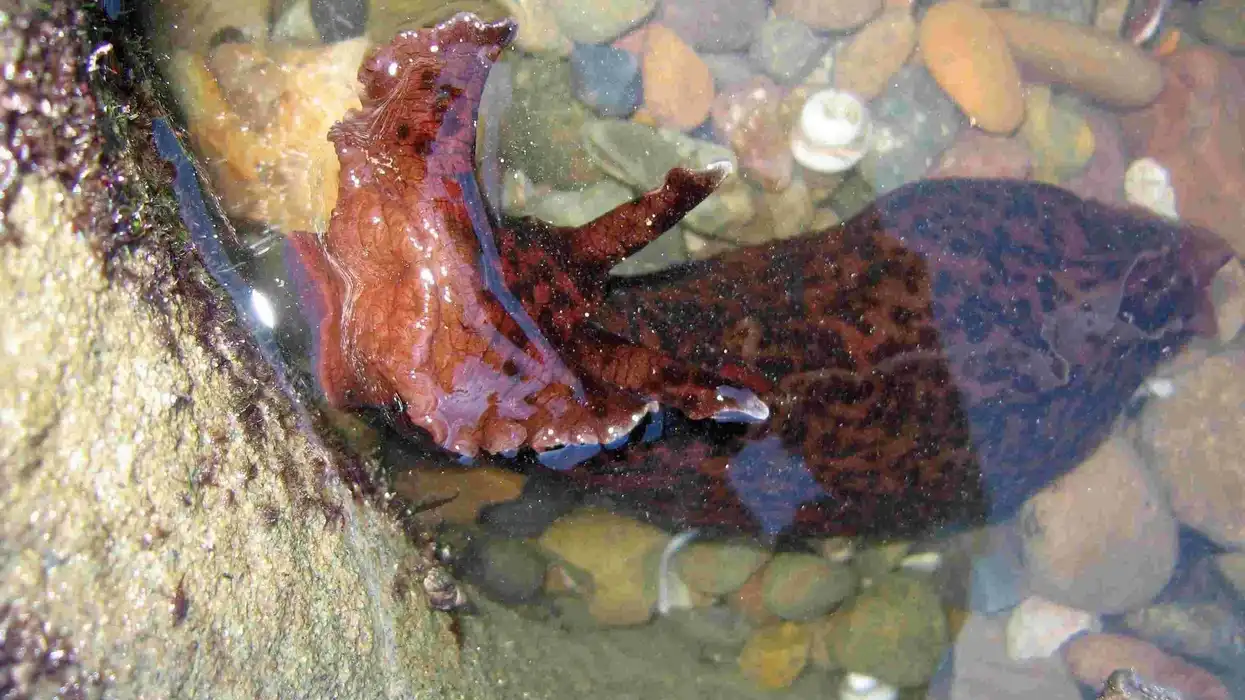The harp seal (scientific name Pagophilus groenlandicus) is also sometimes called the Greenland seal. In Latin, its scientific name literally translates to 'ice-lover from Greenland'.
This is a species of earless seal that is a true seal native to the northernmost Atlantic Ocean and the Arctic Ocean. Originally in the genus Phoca, which includes many other species, in 1844, it was reclassified into the monotypic genus Pagophilus.
The harp seal (Pagophilus groenlandicus) is also called a saddleback seal sometimes because of the black marking it carries on its back, looking like a saddle or a harp. Harp seal adults are sexually dimorphic in nature, and males are typically slightly bigger and heavier than females.
In contrast, males have sharper markings and a darker head.
Some females remain spotted their entire lives without creating any new markings.
Being viviparous in nature, after mating, female harp seals conceive only one harp seal pup, and having twin harp seal pups is really rare. Harp seal mothers prefer to give birth during the short period from February through mid-March because pack ice is available at this time, and it's a great place to nurse their pups.
If you like reading about the harp seal habitat and more in this list of harp seal facts for kids, then you should definitely check out our facts about the common dolphin or plains zebra too.
Harp Seal Interesting Facts
What type of animal is a harp seal?
The harp seal (Pagophilus groenlandicus) is an earless seal species with dark markings on their backs and black heads. Harp seals are the most common name they're known as, though many harp seals are also called saddleback seals, and since they're most commonly found in and around Greenland, they're also often called Greenland seals.
What class of animal does a harp seal belong to?
Harp Seals belong to the Mammalia class as they're viviparous in nature and directly give birth to their young. Harp seal pups are born with yellow-white fur that's initially stained by amniotic fluids but later turns into a pure white fur coat.
Harp seal mothers live with their pups for 12 days while nursing them with high-fat milk. During this time mothers choose to stay right by their pup and don't go anywhere.
How many harp seals are there in the world?
Currently, there is believed to be a population of about 7.6 million harp seals in the world. Even though they're under the Least Concern conservation status, their numbers are steadily declining every year due to illegal poaching, commercial hunting, water pollution, and global warming.
We should do everything we can to protect them before they fall into the Vulnerable or Threatened statuses.
Where does a harp seal live?
The harp seal (Pagophilus groenlandicus) prefers to live in the polar regions of the Arctic Circle. They are generally found in northern Canada, Greenland, and Norway.
One of the most interesting harp seal habitat facts is that they prefer to live in icy climates as harp seals spend most of their time on land, lounging around on the ice, only moving into the water for hunting.
What is a harp seal's habitat?
A typical harp seal habitat is a polar region that has thick covers of ice. With a body weight of around 265- 300 lb (120-135 kg) and being 6 ft (1.8 m) in length, they are very keen hunters.
They catch anything from large fishes to small invertebrates, both of which form an important part of the harp seal food chain. They are skilled hunters who prefer to live near northern oceans and spend their time on land covered with thick pack ice.
Who do harp seals live with?
During breeding and molting seasons, harp seals are seen to live in very large groups. These groups can have up to several thousand seals living together.
Harp seals also love to feed and travel in large groups when migration season kicks in.
They often travel far away from their pack ice habitat during the summer and travel back up to the north when the ice is thick again in the Arctic regions. They can make roundtrips of more than 3,100 miles around the globe on an annual basis and they do this with other harp seals by their side.
How long does a harp seal live?
Harp seals are known to have a life span of around 30 years. Even though the harp seal life cycle does suggest this long lifespan, not many can live for that long in reality because of the very nature in which they live. The average lifespan of a harp seal is actually 20 years.
How do they reproduce?
Harp seals reproduce sexually through males and females mating on land. Having twin pups is rare when harp seals are breeding and normally they produce only one pup.
After an 11.5 month-long gestation period, females give birth during the short period after the mating season from February to mid-March. At this time the pack ice is thick and great for nursing the young harp seal pups during their first 12 days (the nursing period).
What is their conservation status?
Their conservation status is currently Least Concern, but due to steadily declining numbers in the harp seal population, it is feared that they might end up in the Vulnerable status. This is because the gap between their births and deaths is steadily decreasing. Conserving and protecting these wonderful animals should be on our priority list.
Harp Seal Fun Facts
What do harp seals look like?
Harp seals look like any other seal species but their patched skin makes them unique. Due to the harp-shaped marking on their backs, they're called harp seals and they live in the Atlantic and Arctic oceans. After breeding, when pups are born they have a yellow-white fur coat.

*Please note that this is an image of a seal, not specifically a harp seal. If you have an image of a harp seal please let us know at hello@kidadl.com.
How cute are they?
Harp seal is as cute as a water dog can be! Harp seals truly win our hearts with their big black puppy eyes and cute snouted mouth, giving them the perfect nickname of 'water dog'.
Even though they are wild animals, harp seals have an adorable appearance that can be deceiving as they are very skilled hunters. Baby harp seals melt our hearts with their big black eyes and white coats when they're seen hopping around on the ice.
How do they communicate?
Harp seals have a long and varied range of vocal tones that are used for communication. Pups usually call their mothers by making a sound that's called 'bawling'.
And when they're playing, they are often seen 'mumbling'. Harp seal adults growl to warn away any potential threats, and when underwater, they are known to make over 19 different vocal calls, which are often used for courting and mating.
How big is a harp seal?
Average adult harp seals are 6 ft (1.8 m) long. An adult male harp seal size is always bigger than that of a female harp seal. Despite being this long, they're still half the size of both a walrus and a leopard seal.
How fast can a harp seal swim?
Harp seals are skilled swimmers and are often seen swimming around the chilly waters of the North Atlantic and Arctic oceans. They spend the majority of their time loitering around in the snow, but they can dive really deep and are known to stay underwater for 15 minutes at a time.
How much does a harp seal weigh?
An average harp seal can weigh anywhere from 265-300 lb (120-135 kg) and male harp seals are often heavier than females. This weight means nothing to them when they're swimming underwater as a harp seal is both a skilled hunter and skilled swimmer.
What are their male and female names of the species?
There are different names for males and females in the harp seal species, a male harp seal is usually called a bull while a female is called a cow.
What would you call a baby harp seal?
One of the best baby harp seal facts is that it is called a pup. Its big black eyes and white coat can melt anyone's heart at the first sight!
What do they eat?
The average harp seal diet ranges from fish and crustaceans to small invertebrates. Being skilled hunters, a harp seal hunts anything and is not particularly picky about its diet. Harp seals can eat almost any prey that crosses their path as part of their diet.
Are they dangerous?
They look incredibly cute, like a fluffy water dog, but they are actually quite aggressive and can bite humans, potentially causing an infection. That being said, they are social mammals just like us and as long as they approach you and you don't make any sudden movements or spook the creature, all should be well.
Would they make a good pet?
Despite how adorable this animal is, they still are wild animals with wild instincts. They are not to be mistaken for animals that can be kept as pets.
Did you know...
At birth, pups don't have any blubber, but after nursing on their mother's high-fat milk, they quickly gain weight. When the pups reach the weight of 80 lb (36kg) females stop nursing them.
After which pups go without any food for between six and eight weeks and as a result, can end up losing half of their body weight. Later, they learn to dive and can begin to hunt food for themselves.
Harp seal mothers can identify their pups by just their smell and harp seals can stay underwater for 15 minutes.
What are the harp seal's predators?
The harp seal's predators range from polar bears on land to killer whales and sharks in the water. Another big predator is humans as, while other animals hunt them as food, humans hunt them for our own commercial use. The harp seal species needs to be protected against these threats.
Are harp seals endangered?
Luckily, harp seals are not endangered, but the way their numbers have been declining throughout the years is very concerning. From global warming to commercial hunting, we should strive to keep them protected from threats before they become endangered. It is important that these wonderful mammals are protected from any harp seal predators.
Here at Kidadl, we have carefully created lots of interesting family-friendly animal facts for everyone to discover! Learn more about some other mammals including the Amazonian manatee, or the fur seal.
You can even occupy yourself at home by drawing one on our harp seal coloring pages.









